The How to Knit Your First Sock series covers knitting a sock in 4 step-by-step articles.
- How to Knit Your First Sock – Part 1: will cover the anatomy of a sock, knitting the cuff and the leg section.
- Part 2: will explain knitting the heel flap and turning the heel
- Part 3: shows how to set up for the gusset and gusset shaping.
- Part 4: looks at knitting the foot, toe shaping and finishing.
Anatomy of a Sock
At its most basic a sock is a tube of knitted fabric which is open at the top and closed at the toe. But for the sock to be comfortable it is better if it has some shaping to accommodate the heel and remove excess bulk at the toe.
A sock can be knit from the cuff to the toe or from the toe to the cuff.
This step-by-step series features knitting the sock from cuff to toe. A useful reason for knitting your sock from cuff to toe is when you get a hole in the toe it is easy to unravel a few rows of the toe and knit a new one.
The main parts of a sock:
- Cuff – elastic section helps hold the sock up.
- Leg – the length can vary by choice.
- Heel Flap – slip stitch strengthens this.
- Turned Heel – shaping for the heel.
- Gusset Shaping – shaping for the insole.
- Foot – the length can vary to suit your foot.
- Toe – shaping for toe.
Materials
- 100g of 4 ply self-patterning sock yarn. I have used 100% wool for knitting socks but if you don’t have time to hand wash your socks and have a tendency to pop them into a mesh bag and wash them on the cool wool wash in the washing machine, you will find that sock yarn which has 75% wool and 25% nylon works best. This fibre combination wears well and is slow to pill, the colours last don’t fade as quickly and the yarn doesn’t felt during washing.
- 2.75mm set of 5 double-pointed needles (dpns). For sock knitting, you will find that bamboo dpns are ideal. They are flexible and can ease joint pain. Bamboo and wood are slightly ‘sticky’ which helps prevent the stitches from slipping off the needle.
- 3.25mm needle. If you use a larger-sized needle to cast on the stitches loosely it helps prevent the cuff edge from being too tight.
- 2.25mm set of 5 double-pointed needles (dpns). For knitting the toe. These are optional but you may have a set in your needle collection.
- Tapestry needle. For sewing in loose ends.
Abbreviations
- k – knit
- p – purl
- ssk – slip 2 stitches knitwise, one at a time, to the right needle, then insert the left needle from left to right into front loops and knit 2 stitches together – 1 stitch decreased
- p2tog – purl 2 stitches together – 1 stitch decreased
- sl 1 – slip 1 stitch purlwise
- st – stitch
- st st – stocking stitch/stockinette stitch
Cuff
- Using the 4-ply sock yarn and the 3.25mm needle cast on (loosely) 60 stitches.
- Change to the 2.75mm dpns.
- Next, work the first row of k1, p1 rib. Divide over 4 needles as you work this row. 15 sts on each needle.
- Join into a round being careful not to twist the stitches. The loose tail is a useful way of knowing that you are at the back of the sock.
- Work 14 rounds of k1, p1 rib.
- This will give a ribbed cuff which measures 3.5cm/1 3/8 inches. As this is your sock you can add additional depth to the cuff at this point. Just keep a note of how many rows you rib so that you can do the same for the second sock.
- Other rib options work beautifully for the cuff. K2, p2 rib is wonderfully elastic. An elegant solution is k3, p2.
Sock Leg
- Knit 42 rounds
- The length of the sock from the cast on edge after completing these rows is 13.5cm/5 1/4 inches.

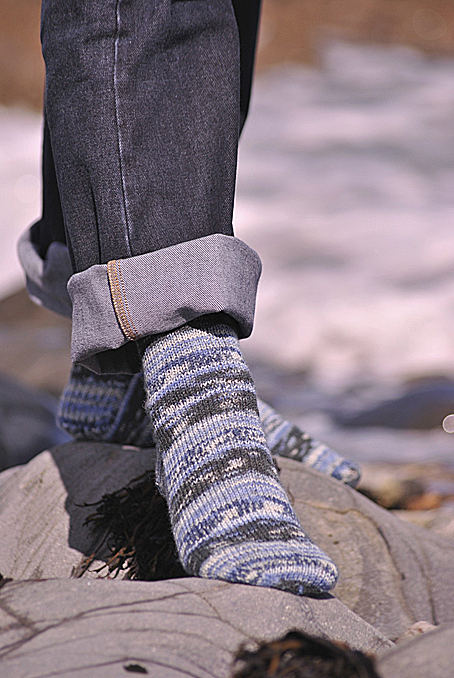
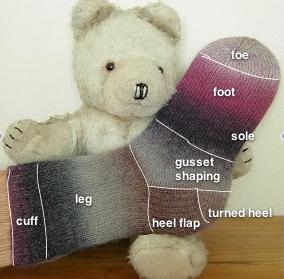
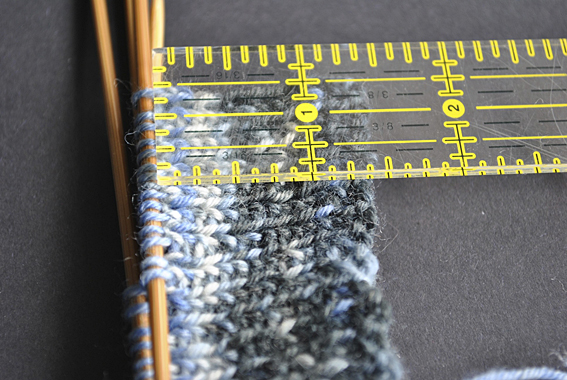
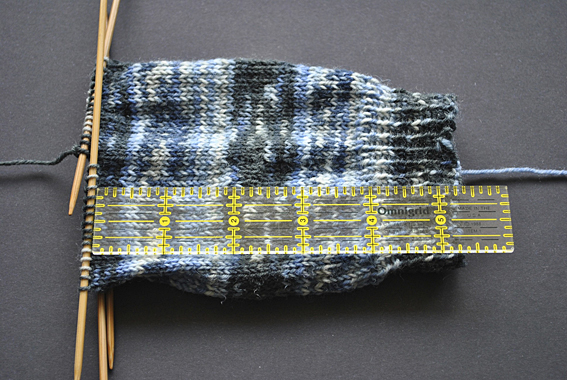
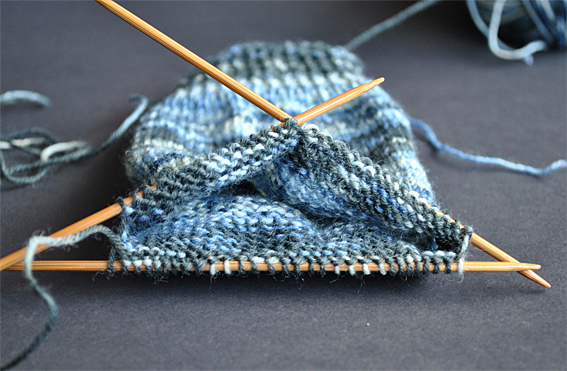
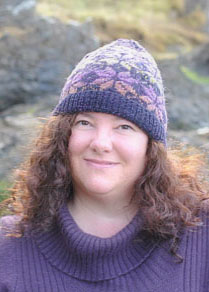
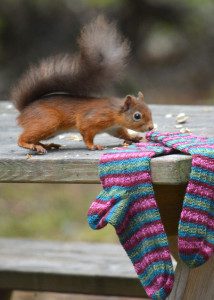
Would you happen to have a basic sock pattern using worsted weight yarn ? I like using the 5dpns, but am horrible at trying to figure out number of stitches &Needle size etc. I would need USA instructions. I’m going to make them for school teens that like to wear them to school activities . Thank you for any help given.
I’d suggest the book “Getting Started Knitting Socks by Ann Budd” she covers knitting a basic sock pattern in several different weights of yarn and gauge for many different sizes of sock from child to adult. She is also American.
I haven’t knit socks using worsted weight yarn as it isn’t easily available in the UK. Nicolette
Thank you so much for the suggestion. I’ll look into that.
I loved this sock pattern! I have made 7pairs for my Alaskan kids. They love them. Thank you do much for sharing!!!
Thank you Pamela, so glad you enjoy knitting the socks! So much fun knitting socks. Nicolette
I have made about 25 pairs of this round toe sock pattern mainly for my friends and family and for people who ask me. I do not ask for payment just to see the pleasure is enough for me. Some of my friends now have a copy of ny original pattern to do them for their families because they are so neat at the toe. The Kitchener stitich is ok for socks made in thicker wool for me. Thank you for letting me have the pattern. Margaret February 9th 2020
Thank you Margaret, I’m glad you like the pattern.
Whoops, I should have said convert from. mm to number for knitting needles! Have been doing a lot of crocheting! Sorry about that!
Hi, Nicolette,
Friends and I get together weekly to make baby hats, lap robes and quilts for hospitals. We have been at it for years; and, have decided that we need to”branch out” and try our luck at making socks. One of our ladies has made socks in the past; I made them 50 years ago for my husband and kids, and one lady has no experience with sock making. I have been checking out some sock making tutorials like yours for a couple weeks now.. I think we will use yours. I have used circular needles, too, but I don’t like socks with seams. So, what should be our first attempt at sock making? Maybe do the top ribbing the first time and proceed from there? I also think we should only work on these in “class”, so we are all on the same page. Those are my thoughts; can you enlighten us with any helpful suggestions? Thanks so Much! Also, Can you convert needle size from mm to the corresponding letter? ( g, h, I, j, etc)
When getting the stitches on the one needle from the 4rh needle do you knit stitches from the 3rd needle or the 1st needle. My first attempt at knitting socks.
Bonnie
Index some thicker socks for sparge size man do you have double knitting pattern
Hi Mo, Check this free Regia Sock Pattern for 6ply yarn (knits as DK). You may find it helpful. Happy sock knitting, Nicolette
Sorry I did not find you sooner. I am still learning even though I’m 76 yrs. Loved you tips on your socks and why to use75 25 yarn. Kitted 20 pair of socks when I first learned they all wore out right away. Learned learned now I know why! Won’t use 100% wool agin
Hi Claudia, I learned the hard way with 100% wool (non superwash) as I had a few pairs of socks that shrank long before they had the chance to have any sort of little holes appearing! Even using the 75% wool 25% nylon sock yarn, the socks will wear out eventually, just giving a lovely reason to knit a nice new pair! Happy Knitting, Nicolette
How do you prevent a ‘ladder’ forming when using dpns?
What I always do and it has become something I don’t even have to think about, each time you change to the next needle, after working the 2nd or 3rd stitch give a little tug to tighten up your yarn and stitches that you’ve just knit, then continue knitting. I find this really helps. Also, it improves with time and practice. I hope that helps. Happy sock knitting, Nicolette
I just finished my first sock but the cuff seems like it is loose and don’t stay up on my leg is there som kind of yarn that has elastic in it to make it stay up better or did I just not do something right?
Hi Kay, Check your tension on your sock and then measure your calf. You may find that you need to cast on 56 stitches for your sock. This sock pattern starts with 60 stitches. But, often a sock will slip down your leg if you haven’t enough stitches and the cuff is a little bit too snug. In which case you may need to cast on 64 stitches. In this pattern, I used a 1×1 rib but you may prefer to use a 2×2 rib which has a bit more stretch to it. How to Knit Your First Sock is a photographic step by step tutorial to help with knitting a sock. I do have a pattern The Basic Sock Pattern in 6 Sizes which covers a wider range of shoe sizes. I hope that helps. Happy sock knitting, Nicolette
Yes thank you for your help
That worked thank you can you let me know how to unknitt? I usually pull the needles and then have a problem getting all my stitches back
Hi Kay, Normally, I just pick up the stitch directly under the one I have just knit and then carefully pull the yarn out of the stitch, then repeat with the next stitch. It is slow. Sometimes, the unknit stitches are twisted on the needle so you need to keep an eye on that when you start knitting them again. Hope that helps, Nicolette
I am only a size 4…. What size foot is your pattern for?
Hi Faye, I’m just out of hospital and not up to date with replying to comments. This pattern is for UK size 5-6. This pattern shows in detail how to knit your first sock. I do have a pattern that gives a variety of sizes. Basic Sock Pattern in 6 sizes this link is to the 3 smaller sizes. Hope this helps. Nicolette
Im only a size 4…. How do i work out how many stitches to cast on etc… What size is your pattern for?
When i finish the cuff how do i get the 30 stitches on the one needle so that the working yarn is to the right??? I knit 30 on but that left 10 on the one needle and I really don’t understand. Thanks for your help
Hi Amy, By cuff, does this mean you’ve finished knitting the k1, p1 ribbed cuff for 14 rounds. This would mean that you have 15 stitches on each of 4 double pointed needles. And you are now ready to knit the leg section of the sock. For the leg, you will be knitting all the stitches on each needle and no longer purling any of them. It is when you finish the leg section that you will be ready to work on the heel flap.
You only need to knit on 30 stitches when you are knitting the sock heel flap. Can you let me know which stage you are at with your sock and then I’ll be able to help you. Happy Sock Knitting, Nicolette
hi my name is daniel im a beginner in making socks… i was wondering if it was ok to use a wool & alpaca blend? also if i could just use the 3.25 DPNS for the whole project? I’m also having a hard time finding sock yarns here in australia.. thanks <3
Hi Daniel, Sorry not to have replied sooner, I’ve been away in Brittany. Normally, you’d use a wool blend that contains a stronger yarn than the wool such as nylon or silk. Alpaca isn’t a particularly strong fibre. I’ve used 100% alpaca in some of my socks, they feel wonderfully soft to wear but haven’t been a long lasting pair of socks on heels and toes. You may find that 3.25 mm DPNs may knit up as fabric that is a bit too loose. A tighter tension will help with how long your socks last and how well they wear. Some people buy a nylon yarn that can be knit at the same time as the heel or toe to add strength. I haven’t used this myself so I don’t know how well it wears or how comfortable it is. I normally use a wool/nylon blend yarn for knitting my socks with 2.75mm DPN’s. I post sock yarns to Australia on a regular basis! Hope that helps. Happy Sock Knitting, Nicolette
I like this well explained pattern, though the addition of a row marker would be helpful, especially at the shaping time and toe time. Thank you.
I love your tutorial and now I’m ready. I promised my daughters fiancé a pair of socks two years ago. I rally should get them done. How can I adjust this pattern for a men’s size 11?
Dawn
Hi Dawn, Is he a UK, US or Europe men’s size 11? My pattern has a tension of 7.5 stitches/(2.5 cm/1″) on stocking stitch knit in the round using Opal Sock Yarn. I use 2.75 mm double pointed needles but lots of people like a slightly tighter tension and use 2.5 mm needles.
US 11/Europe 45/UK 10.5 I’d cast on 68 stitches so 17 stitches per needle and the heel would be worked over 34 stitches.
US 11.5/Europe 45.5/UK 11 Most patterns cast on 72 stitches so 18 stitches per needle and the heel would be worked over 36 stitches.
You really want to measure his foot, ankle and calf (how long he’d like his socks). Ideally, you should have negative ease of between 5% and 10%. I personally like negative ease of 5%.
So if you measure around his foot and his ankle (usually a similar measurement) and it is, say, 10″ and the tension of your sock is 7.5 stitches/inch, 10 x 7.5 = 75 stitches, then take off the negative ease 5% = 71.25 stitches (so I’d cast on 72 stitches), or negative ease of 10% = 67.8 stitches (so I’d cast on 68 stitches).
Also, if the sock is slightly longer in length, you can cast on and knit the cuff using needles a size larger and then about half way down the leg, switch to the smaller sized needles. Gives some additional stretch for the calf.
For the foot length, I normally knit the foot until I’m about 2 inches from the tip of the toes, then I start the toe shaping. It would really help if he could try on the sock before you start toe shaping as it is so much easier to see if you need to knit another row or not.
I hope that this is helpful.
Happy Knitting,
Nicolette
Correct me, but this *brilliant* pattern makes a size medium sock, right? Is there an easy way to make this fit a small foot (a size 5/6 American)? I’m a complete beginner to socks, so I don’t know how just casting on 50 instead of 60 stitches would work. I don’t know how well it would translate to the gusset and the heel flap and the rest of the sock past the leg part that’s knitted. Can someone help please?
Thank you for your comment.
I have emailed you some information for knitting a smaller sock. I hope that helps.
I have emailed you some helpful suggestions. Happy Sock Knitting, Nicolette
Great recap of basic sock knitting.
I have a question.. I’m fairly proficient at knitting socks from a pattern but I’ve decided to try winging it. I want to knit a basic sock on 3 DPNs with a simple (P2, C2F, P1, C2B, P2) cable on each side of the leg. My question is this: at what points on 3 DPNs do I begin working the cables so they’ll be positioned evenly on each side of the leg? I’ve started my sock with 50 sts (16 – 18 – 16)
Thanks,
Barb
Hi Barb, I’m glad that you found the post helpful. If I was knitting the sock, with the two 9 stitch cables, I would have the stitches spread over 4 needles rather than 3, so for your 50 stitch sock, I’d have 16 stitches at the back, 9 stitches for the cabling, 16 stitches at the front, then 9 stitches for the cabling. I’d start and end my rounds in the centre of the back. Over 3 needles, I’d have 16 stitches at the back leg, then needle 2 would have 9 stitches for cable, place a stitch marker then 8 stitches to centre front, needle 3 would have 8 stitches to start of cable, place a stitch marker then 9 stitches for the cable. Hope that helps. Nicolette
I am fairly new to knitting, but understand all the basic stitches. I guess what does confuse me, is what does it mean by rounds?
Basically, knitting in rounds means you are knitting in a circular fashion either using a set of double pointed needles or a circular needle rather than knitting flat from side to side and turning your work. Circular knitting means there are no seams, which is why it is normally used for knitting socks.
OH OH OHHHHHH! Can I hug you! *HUGS* I want to make socks and this will help SO very very much! Have a wonderful weekend! 😀
You will love knitting your own socks. Sock knitting should come with a warning though. It can become a bit addictive. Have fun. If you have any questions let me know.
Nicollete,
Obrigada por publicar este maravilhoso trabalho!!
Agora, só não faz uma meia quem não quer!!
Você foi simplesmente genial em seu tutorial.
Obrigada, mesmo, daqui do Brasil!!
Elza Guerra
Hi Elza, thank you for your kind comment. I hope you are enjoying knitting your socks. Nicolette